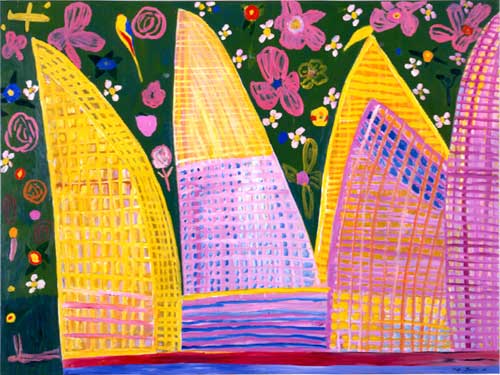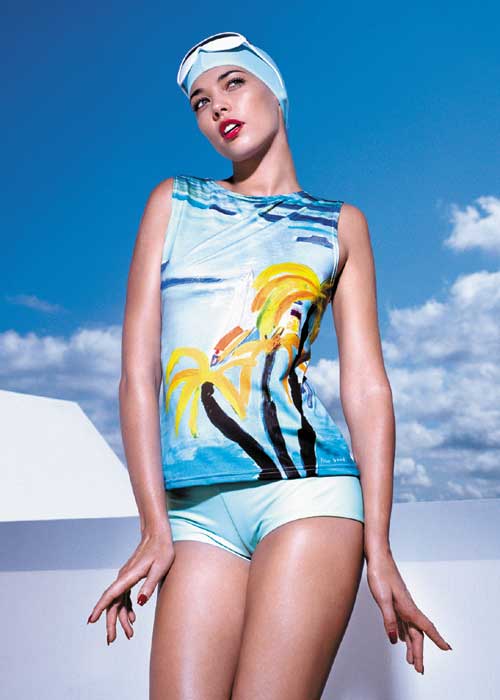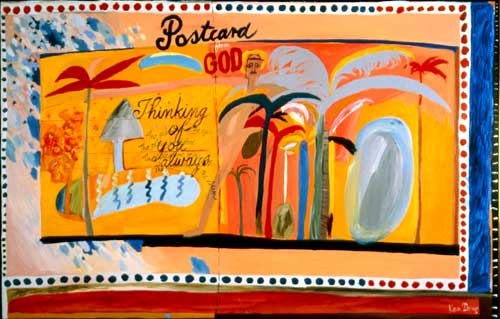Rebecca Hossack Gallery, London
19 November-23 December 2004
Done's career has been the subject of more press than most - but it is press rather than art criticism, focusing on the issues surrounding the debate between art and design. The reason for this is not simply that there is a weak link between art and industry in Australia and little real dialogue between artists and designers, but more that Ken Done is considered far more successful, in commercial terms, than is deemed acceptable. In Australia, a sensibility seems to prevail in the art world that artists should not have a commercial agenda. Indeed, philosophy and the market place have been thought to be mutually exclusive. It is difficult to believe, outside of Australia, just how vitriolic the criticism of one of Australia's best-known artists has been.

Opera House and Botanic Gardens, 1998, acrylic on canvas, 150 x 200 cms
Ken Done's contribution to Australian art is considerable. His company, Done Art and Design, which he runs with his family, is a cultural, artistic and business phenomenon and is unique in terms of the scale of its success. The company was developed in the early 1980s, at a time when Australia was experiencing a surge in national pride and discovering a new identity, partly due to increased levels of tourism as a result of the world's discovery of Australia as an unspoiled paradise.
With a background in advertising, Done did not turn to full-time painting until he was almost 40. The influences on his career are many and varied, but what characterises his work is the independence of his choices. While most artists in Australia travelled to Europe after finishing their studies, Done visited Japan in 1962 and America in 1964. His relationship with Japan, in terms of its attitude to design and the subsequent success of his work there, reflect the unreserved embrace of an Eastern aesthetic from a young age. After working for J. Walter Thompson in America, Done relocated to their London office in 1965 and then to their Sydney office in 1970.
Done's graphic work was influenced by the Pop colours and imagery of Milton Glaser and the Push Pin Studios in California. It developed beyond a Pop Art look, however, with the influence of Japanese design - although Pop Art continued to inform his attitude to the role of art in society. Done has won many awards for his graphic art, in Australia and abroad. The second area of his design work grows out of his painting. 'Art to Wear' takes paintings, or details of paintings, and simplifies and adapts them for printing onto fabric and manufacturing into clothing. This he does jointly with his wife, Judy, fashion designer and business woman. 1
In London in the 1960s, Done encountered the media-inspired advertising industry. Pop Art encouraged his philosophy of communicating with a wide audience and a move away from traditional hierarchies in art and it was during this time that Done's philosophy of a mutual development between art and design was formed. With the culture of Pop Art, came a renewed concern with the everyday world, especially the consumer-oriented areas of packaging and advertising art. Pop Art employed an imagery that was easy to identify with. Done's comments years later, after the phenomenal success of his art enterprise, represent the legacy of attitudes prevalent in Japan, and in London, throughout the period in which he worked there. He has said, 'I like art that has a wide distribution. It does not always have to be deep and complex. In Japan they understand that simple objects can also be beautiful. In the times in which we live it is far too restricting to say that art can only be found in art galleries and not touch people's everyday lives.' 2
Christopher Finch, in his important book from this period, Image as Language: Aspects of British Art 1950-1968, observes that in the second half of the 1950s, the arts became a subject of great interest and controversy. This partly manifested itself in a focus on the artists themselves, who were being treated in a manner previously reserved for entertainers or fashion designers. Finch believes this can be traced back to the New York artists Jasper Johns and Robert Rauschenberg. A folk-hero status was thus accorded to British artists such as Peter Blake and David Hockney and to the expatriate American in London, Ron Kitaj. The cult of personality was an extension to some degree of the 19th century romantic image of the artist, but in a newly glamorous and materially successful world. 3 For Hockney, the cult of personality did not obscure serious critical discourse of his work because he was already an acclaimed artist. In contrast, Done received media attention at a very early stage in his career and his public image was formed before he was ready to face the critics.

Recent clothing from Done Art and Design, 2004
The lessons of the Pop Art movement in 1960s Britain have not, it would appear, been carried through to the present, at least in Australia. Christopher Finch acknowledges that Pop Art was not a movement with 'an exclusive method of treatment or investigation. Rather, it opened its windows on the world at large and accepted everything that presented itself; it was an art of inclusion'. 4 Artistic experience was enlarged to include a wider range of imagery and application. A 'close and easy relationship between the arts and popular media in London' was nurtured by the music industry, media links with New York and an advertising industry, attracting brilliant and amusing writers and artists. Such a close liaison between the music industry, media, fashion and the plastic arts has never existed in Australia. This perhaps explains the fascination on the part of the media on one hand and the antipathy from the Australian art establishment on the other, towards Ken Done's unorthodox and 'brilliant career'.

Postcard from God, 1976, oil on canvas, 110 x 104 cms
Ken Done continued to work as a painter during his career in advertising. 'Postcard from God' (1976) was painted shortly before Done left his advertising job. It marks a turning point in his work, as it incorporates a number of his preoccupations at that time. In formal terms, it displays the proficient graphic devices of the highly successful advertising artist. It also displays wit and irreverence. The very notion that God might send a postcard - that efficient communication of the traveller, a symbol of tourism - challenges both religious boundaries and established form in religious art. Yet the comment on religion is not glib - the candour and innocence of the child (an idea central to Christianity), is also represented in this work. The written text on the painting, 'Thinking of you always', is a subtle and personal response to the existence of a higher order. This enlarged postcard, its message amplified to reach a wide audience in a gallery, as opposed to an individual via the post system, symbolises Done's receptivity to the art movements of the 1960s and 1970s - movements that sought to extend the boundaries of art practice. 'Postcard from God' was exhibited in the Blake Prize for Religious Art in 1978 and while it did not win the prize, it was reproduced on the front page of the Sydney Morning Herald (14 September 1978) and singled out for praise by its reviewer, Nancy Borlase.
In June 1980, Done held his first solo exhibition at the Holdsworth Galleries in Sydney. Later that year, he opened the Art Directors' Gallery in Ridge Street, North Sydney, with a second solo exhibition. For his second show he made 12, single colour, silk-screen printed T-shirts. Designed as a simple promotional device for his exhibition, the T-shirts were a great success, largely because of the enthusiastic response they received from the staff at Vogue Australia in Sydney.
Done found ways of earning money to support himself and his family while continuing to paint. He had acquired business skills through his work in advertising and the running of his own design companies, and he approached his new life as an artist with business flair and acumen. Done did not regard his business skills as inappropriate to the role of artist.
In Ken Done's Image Problem, Peter Anderson observes: 'For while the art world is happy to stand back at a safe distance in order to subject popular culture to intellectual scrutiny, it has been extremely careful to maintain its own status by keeping the two spheres distinct and separate, with fine art, of course firmly on top. Done's willingness to work openly and unselfconsciously in both fields clearly undermines this hierarchy, which is one of the reasons it seems to be so threatening.' 5 It is this issue which reveals both Done's radicalism and his commitment to producing and demystifying art for a wide audience. Marie Geissler believes that it is because Done has such strong ideas that his work is so successful in commercial terms.6 Done has achieved artistic success by believing that what he is doing is truly necessary and beneficial. He has a stylistic affinity with the early modernists and a love of everyday objects, which make his subject matter accessible rather than elitist.
The advertising industry exposed Done to the world of media, photography and film. Yet, as an artist, he is well aware of the necessity of adjusting the role of art as a means of communicating ideas. In Done's view, painting, in comparison with photography or film, is no longer the most appropriate, or effective means of conveying political ideas. He believes that, 'A lot of painters haven't really come to terms with the power of television and the rest of the media. I don't use paintings in political terms, I am much more interested in paintings which are about the beautiful things in the world but that does not mean I want them to be shallow. There isn't one painting, for instance about the Vietnam War that even remotely rivals the famous photograph of the little girl running away from the napalm attack. There isn't one painting about the student uprising in China to compete with the television image of the man standing in front of the tank. The power of television, putting images into homes, has changed the role of art in society.'7
The interaction between the culture of the mass media and fine art has played an important part in cultural life since the 1950s. The 'direct transference of photographic imagery to canvas by mechanical means', is not the only way in which the sensibility of the ad/mass processed image has affected other artists. In Britain, the work of Richard Hamilton, American-born Ron Kitaj and Eduardo Paolozzi all approached ad/mass imagery from an analytical and critical perspective.8
For Ken Done, art in a world dominated by mass media falls into distinct categories; design work, or art for a wide audience which uses the means of industry and technology or painting as a primal activity, on which human marks are tantamount. The act of painting links human activity through the centuries, from cave painting onwards.
Since the 1970s, Australian, Aboriginal culture has become well known around the world. No white artist working in Australia could remain unaffected and unmoved by Aboriginal art and culture, or by the pathos, drama and tragedy of the experiences of Indigenous Australians since White settlement. The symbolism and formal elements of the Aboriginal visual language have also exerted considerable influence on Australian art as a whole. In the present exhibition, there is a small version of the Bridge series (1996-97), one of the works in which Done reveals his commitment to Aboriginal issues. Using two of the great icons of Australia - the Sydney Harbour Bridge, representing White society and Iluru, or Ayres Rock, the majestic and profound natural form symbolising Aboriginal culture, Done presents an image intended to inspire harmony and co-operation.9
It is appropriate that Done should be exhibiting at the gallery of fellow Australian, Rebecca Hossack, who has run her London gallery now for over 20 years. Hossack also has an altruistic commitment to Aboriginal art and culture - she is largely responsible for introducing Aboriginal art to Britain and enjoys bringing Done's radiant image of Australia to Northern climes.
References
1. Measham T. Ken Done: The Art of Design. Sydney: Powerhouse Museum, 1994.
2. Artist's Statement, Ken Done: Major Exhibition. Japan: The Yomiuri Shimbun 1991: 3.
3. Finch C. Image as Language, Aspects of British Art, 1950-1968. London: Pelican Books/Penguin, 1969.
4. Ibid, p.14.
5. Anderson P. Ken Done's Image Problem. Art Monthly Australia 1995; 85: 5.
6. Geissler M. Ken Done Design Ink. Dec 1991; 7: 20.
7. Dennis A. The two sides of an artist: Ken Done. Sydney: Airways, 1991: 36.
8. Finch C. Pop Art: Object and Image. London: Studio Vista/Dutton Pictureback, 1968: 115.
9. McKenzie J. The Art of Ken Done. Sydney: Craftsman House, 2002.